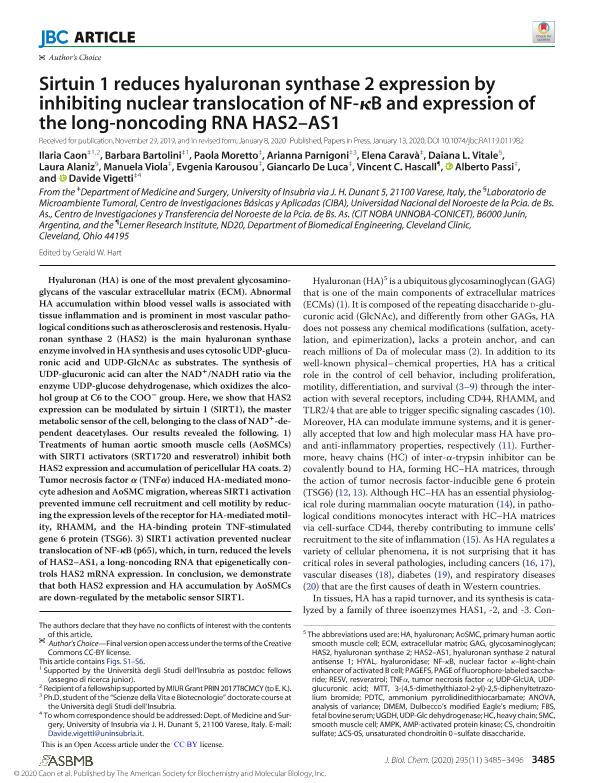Mostrar el registro sencillo del ítem
dc.contributor.author
Caon, Ilaria
dc.contributor.author
Bartolini, Barbara
dc.contributor.author
Moretto, Paola
dc.contributor.author
Parnigoni, Arianna
dc.contributor.author
Caravà, Elena
dc.contributor.author
Vitale, Daiana Luján

dc.contributor.author
Alaniz, Laura Daniela

dc.contributor.author
Viola, Manuela
dc.contributor.author
Karousou, Evgenia
dc.contributor.author
de Luca, Giancarlo
dc.contributor.author
Hascall, Vincent C.
dc.contributor.author
Passi, Alberto

dc.contributor.author
Vigetti, Davide
dc.date.available
2021-11-09T01:29:52Z
dc.date.issued
2020-03
dc.identifier.citation
Caon, Ilaria; Bartolini, Barbara; Moretto, Paola; Parnigoni, Arianna; Caravà, Elena; et al.; Sirtuin 1 reduces hyaluronan synthase 2 expression by inhibiting nuclear translocation of NF-κB and expression of the long-noncoding RNA HAS2–AS1; American Society for Biochemistry and Molecular Biology; Journal of Biological Chemistry (online); 295; 11; 3-2020; 3485-3496
dc.identifier.issn
0021-9258
dc.identifier.uri
http://hdl.handle.net/11336/146353
dc.description.abstract
Hyaluronan (HA) is one of the most prevalent glycosaminoglycans of the vascular extracellular matrix (ECM). Abnormal HA accumulation within blood vessel walls is associated with tissue inflammation and is prominent in most vascular pathological conditions such as atherosclerosis and restenosis. Hyaluronan synthase 2 (HAS2) is the main hyaluronan synthase enzyme involved in HA synthesis and uses cytosolic UDP-glucuronic acid and UDP-GlcNAc as substrates. The synthesis of UDP-glucuronic acid can alter the NAD+/NADH ratio via the enzyme UDP-glucose dehydrogenase, which oxidizes the alcohol group at C6 to the COO- group. Here, we show that HAS2 expression can be modulated by sirtuin 1 (SIRT1), the master metabolic sensor of the cell, belonging to the class of NAD+-dependent deacetylases. Our results revealed the following. 1) Treatments of human aortic smooth muscle cells (AoSMCs) with SIRT1 activators (SRT1720 and resveratrol) inhibit both HAS2 expression and accumulation of pericellular HA coats. 2) Tumor necrosis factor α (TNFα) induced HA-mediated monocyte adhesion and AoSMC migration, whereas SIRT1 activation prevented immune cell recruitment and cell motility by reducing the expression levels of the receptor for HA-mediated motility, RHAMM, and the HA-binding protein TNF-stimulated gene 6 protein (TSG6). 3) SIRT1 activation prevented nuclear translocation of NF-κB (p65), which, in turn, reduced the levels of HAS2–AS1, a long-noncoding RNA that epigenetically controls HAS2 mRNA expression. In conclusion, we demonstrate that both HAS2 expression and HA accumulation by AoSMCs are down-regulated by the metabolic sensor SIRT1.
dc.format
application/pdf
dc.language.iso
eng
dc.publisher
American Society for Biochemistry and Molecular Biology

dc.rights
info:eu-repo/semantics/openAccess
dc.rights.uri
https://creativecommons.org/licenses/by/2.5/ar/
dc.subject
HAS2
dc.subject
HAS2-AS1
dc.subject
SMC
dc.subject
metabolic regulation
dc.subject
epigenetics
dc.subject.classification
Bioquímica y Biología Molecular

dc.subject.classification
Ciencias Biológicas

dc.subject.classification
CIENCIAS NATURALES Y EXACTAS

dc.title
Sirtuin 1 reduces hyaluronan synthase 2 expression by inhibiting nuclear translocation of NF-κB and expression of the long-noncoding RNA HAS2–AS1
dc.type
info:eu-repo/semantics/article
dc.type
info:ar-repo/semantics/artículo
dc.type
info:eu-repo/semantics/publishedVersion
dc.date.updated
2021-10-29T13:16:16Z
dc.journal.volume
295
dc.journal.number
11
dc.journal.pagination
3485-3496
dc.journal.pais
Estados Unidos

dc.journal.ciudad
Bethesda, Maryland
dc.description.fil
Fil: Caon, Ilaria. Universitá Degli Studi Dell´insubria; Italia
dc.description.fil
Fil: Bartolini, Barbara. Universitá Degli Studi Dell´insubria; Italia
dc.description.fil
Fil: Moretto, Paola. Universitá Degli Studi Dell´insubria; Italia
dc.description.fil
Fil: Parnigoni, Arianna. Universitá Degli Studi Dell´insubria; Italia
dc.description.fil
Fil: Caravà, Elena. Universitá Degli Studi Dell´insubria; Italia
dc.description.fil
Fil: Vitale, Daiana Luján. Consejo Nacional de Investigaciones Científicas y Técnicas. Centro de Investigaciones y Transferencia del Noroeste de la Provincia de Buenos Aires. Universidad Nacional del Noroeste de la Provincia de Buenos Aires. Centro de Investigaciones y Transferencia del Noroeste de la Provincia de Buenos Aires; Argentina
dc.description.fil
Fil: Alaniz, Laura Daniela. Consejo Nacional de Investigaciones Científicas y Técnicas. Centro de Investigaciones y Transferencia del Noroeste de la Provincia de Buenos Aires. Universidad Nacional del Noroeste de la Provincia de Buenos Aires. Centro de Investigaciones y Transferencia del Noroeste de la Provincia de Buenos Aires; Argentina
dc.description.fil
Fil: Viola, Manuela. Universitá Degli Studi Dell´insubria; Italia
dc.description.fil
Fil: Karousou, Evgenia. Universitá Degli Studi Dell´insubria; Italia
dc.description.fil
Fil: de Luca, Giancarlo. Universitá Degli Studi Dell´insubria; Italia
dc.description.fil
Fil: Hascall, Vincent C.. Lerner Research Institute; Estados Unidos
dc.description.fil
Fil: Passi, Alberto. Universitá Degli Studi Dell´insubria; Italia
dc.description.fil
Fil: Vigetti, Davide. Universitá Degli Studi Dell´insubria; Italia
dc.journal.title
Journal of Biological Chemistry (online)

dc.relation.alternativeid
info:eu-repo/semantics/altIdentifier/url/http://www.jbc.org/lookup/doi/10.1074/jbc.RA119.011982
dc.relation.alternativeid
info:eu-repo/semantics/altIdentifier/doi/http://dx.doi.org/10.1074/jbc.RA119.011982
Archivos asociados
